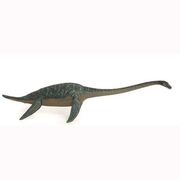| Hydrotherosaurus | ||||
|---|---|---|---|---|

| ||||
| Name | Hydrotherosaurus | |||
| Class | Sauropsida | |||
| Order | Plesiosauria | |||
| Suborder | Plesiosauroidea | |||
| Family | Elasmosauridae | |||
| Name Translation | "water beast lizard" | |||
| Period | Late Cretaceous | |||
| Location | California | |||
| Diet | Fish and smaller sea creatures | |||
| Length | 13 meters | |||
Hydrotherosaurus was a genus of large plesiosaur, belonging to the family of Elasmosauridae. Hydrotherosaurus lived during the Late Cretaceous Period, about 70-65 million years ago, and reached up to thirteen meters (42 feet) in total body length. It was among the largest elasmosaurid plesiosaurs to have ever lived, falling just short of the massive Elasmosaurus. Although there are some differences, such as the teeth issue, Hydrotherosaurus and Elasmosaurus were very much alike. Its name means "water beast lizard". Fossil specimen of the type species of Hydrotherosaurus, Hydrotherosaurus alexandrae, have been discovered in Fresno County, California and in Colorado in the year of 1943 by the American paleontologist Samuel Paul Welles. The type species was named by Samuel Paul Welles in honor of Annie Montague Alexander (1867-1950), a well-known American fossil collector that worked closely with the University of California. Hydrotherosaurus is only known from the complete skeleton that Welles discovered in 1943.
Physiology
Hydrotherosaurus was one of the largest varieties of Elasmosaur. It reached up to thirteen meters in total body length, with a neck that counted for about half of that. Its neck consisted of 60 vertebrae, an exceptionally large number.

When compared to other elasmosaurs, Hydrotherosaurus has one of the greatest percentages of neck proportionality in contrast to total body length. Hydrotherosaurus had a small head that was about 33 centimeters (12 inches) long, a streamlined body, and four large flippers that were specially designed to help the huge animal balance, move, and accelerate itself.
Being one of the larger varieties of elasmosaurid plesiosaurs, most would presume that Hydrotherosaurus was capable of consuming larger types of fish. This may not have been possible. Evidence from fossil specimens show a potential problem for Hydrotherosaurus' ability to catch and hold on to its slippery prey.
Teeth
Hydrotherosaurus, among other elasmosaurs, had what seemed to be oddly shaped teeth. The majority of elasmosaurs had teeth that were long and pointed, in order to help them catch and hold on to their prey. Unlike these, Hydrotherosaurus' teeth were long, pointed, and angled in such a way that they jutted outward. This would have actually made catching and holding on to prey more difficult.
Some scientists suggest that the arrangement of their teeth could have been used as a sort of trap for catching small fish or invertebrates. Although this theory might be true, more research has led some scientists to the conclusion that the seemingly strange tooth arrangement was used as a rake for digging or shifting the sand at the bottom of the ocean or sea. Neither theory has been proven and the reason for Hydrotherosaurus' seemingly misshaped teeth remains a mystery.
Movement
Hydrotherosaurus' swimming patterns are very similar to that of most plesiosaurs. It had four large flippers, paddle-like limbs, that were used in different ways to help the massive animal balance, turn, move vertically, swim horizontally, and get the animal wherever it needed to go. Although the same swimming pattern remains mostly the same for all elasmosaurid plesiosaurs, it is not always the same for other plesiosaurs and marine reptiles. Other marine reptiles, like those in the the plesiosaur superfamily of Pliosauridae, there are some variations to the swimming pattern, due to their drastically shorter necks. Factors like these can make all the difference in the sensitive process of marine locomotion. Hydrotherosaurus needed its flippers to be functional so that it could swim efficiently enough to accelerate and hunt its prey. It is crucial that its fins work properly, a damaged limb for any marine reptile could decrease its ability to do things as normal and possibly, lead to death because of this.
In popular culture
- A Hydrotherosaurus appears near the end of The Land Before Time IV: Journey Through the Mists where it chases Dil the Deinosuchus. However, its role was brief.
Template:Featured article